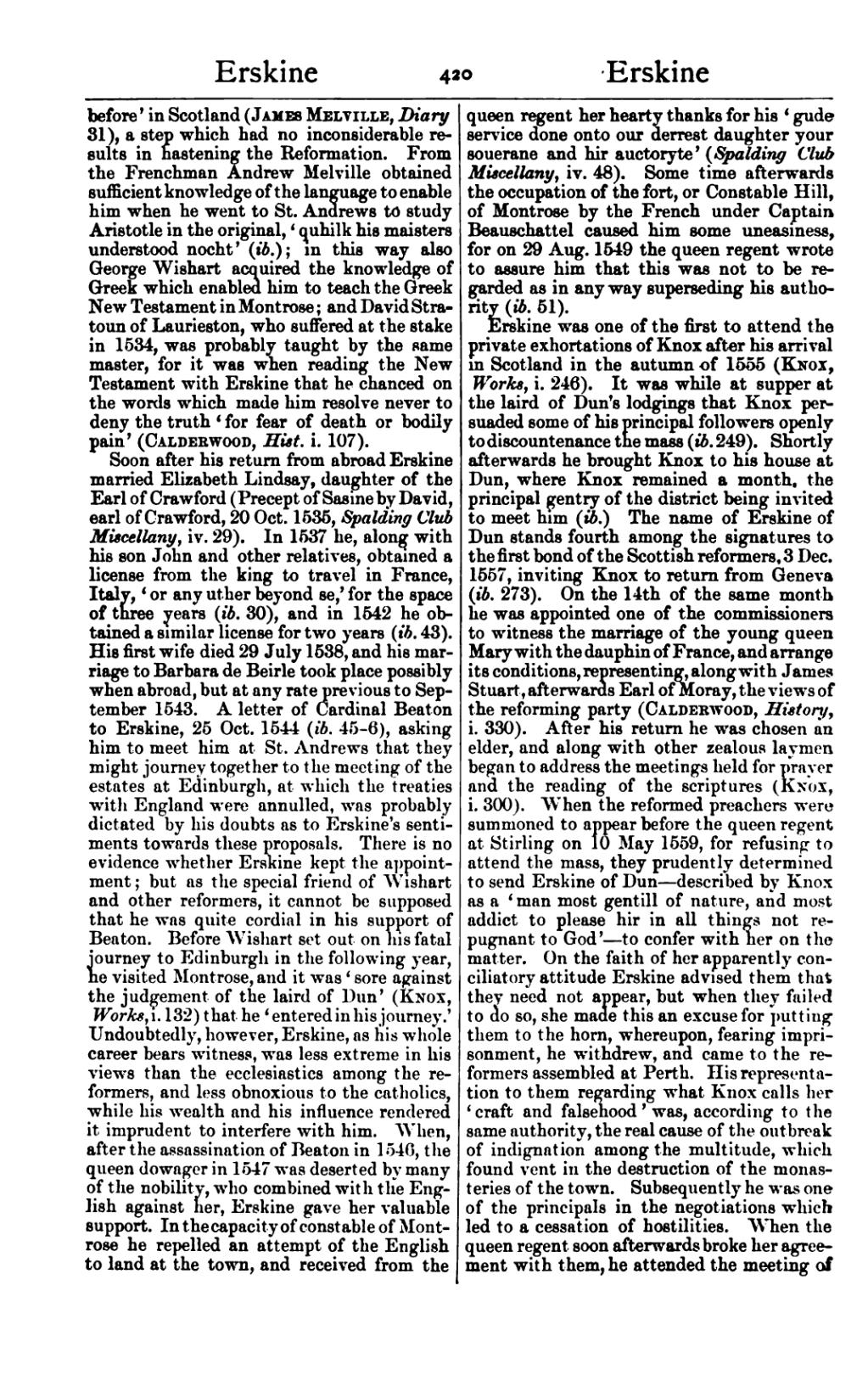before’ in Scotland (James Melville, Diary, 31), a step which had no inconsiderable results in hastening the Reformation. From the Frenchman Andrew Melville obtained sufficient knowledge of the language to enable him when he went to St. Andrews to study Aristotle in the original, ‘quhilk his maisters understood nocht’ (ib.); in this way also George Wishart acquired the knowledge of Greek which enabled him to teach the Greek New Testament in Montrose; and David Stratoun of Laurieston, who suffered at the stake in 1534, was probably taught by the same master, for it was when reading the New Testament with Erskine that he chanced on the words which made him resolve never to deny the truth ‘for fear of death or bodily pain’ (Calderwood, Hist. i. 107).
Soon after his return from abroad Erskine married Elizabeth Lindsay, daughter of the Earl of Crawford (Precept of Sasine by David, earl of Crawford, 20 Oct. 1535, Spalding Club Miscellany, iv. 29). In 1537 he, along with his son John and other relatives, obtained a license from the king to travel in France, Italy, ‘or any uther beyond se,’ for the space of three years (ib. 30), and in 1542 he obtained a similar license for two years (ib. 43). His first wife died 29 July 1538, and his marriage to Barbara de Beirle took place possibly when abroad, but at any rate previous to September 1543. A letter of Cardinal Beaton to Erskine, 25 Oct. 1544 (ib. 45–6), asking him to meet him at St. Andrews that they might journey together to the meeting of the estates at Edinburgh, at which the treaties with England were annulled, was probably dictated by his doubts as to Erskine's sentiments towards these proposals. There is no evidence whether Erskine kept the appointment; but as the special friend of Wishart and other reformers, it cannot be supposed that he was quite cordial in his support of Beaton. Before Wishart set out on his fatal journey to Edinburgh in the following year, he visited Montrose, and it was ‘sore against the judgement of the laird of Dun’ (Knox, Works, i. 132) that he ‘entered in his journey.’ Undoubtedly, however, Erskine, as his whole career bears witness, was less extreme in his views than the ecclesiastics among the reformers, and less obnoxious to the catholics, while his wealth and his influence rendered it imprudent to interfere with him. When, after the assassination of Beaton in 1546, the queen dowager in 1547 was deserted by many of the nobility, who combined with the English against her, Erskine gave her valuable support. In the capacity of constable of Montrose he repelled an attempt of the English to land at the town, and received from the queen regent her hearty thanks for his ‘gude service done onto our derrest daughter your souerane and hir auctoryte’ (Spalding Club Miscellany, iv. 48). Some time afterwards the occupation of the fort, or Constable Hill, of Montrose by the French under Captain Beauschattel caused him some uneasiness, for on 29 Aug. 1549 the queen regent wrote to assure him that this was not to be regarded as in any way superseding his authority (ib. 51).
Erskine was one of the first to attend the private exhortations of Knox after his arrival in Scotland in the autumn of 1555 (Knox, Works, i. 246). It was while at supper at the laird of Dun's lodgings that Knox persuaded some of his principal followers openly to discountenance the mass (ib. 249). Shortly afterwards he brought Knox to his house at Dun, where Knox remained a month, the principal gentry of the district being invited to meet him (ib.) The name of Erskine of Dun stands fourth among the signatures to the first bond of the Scottish reformers, 3 Dec. 1557, inviting Knox to return from Geneva (ib. 273) On the 14th of the same month he was appointed one of the commissioners to witness the marriage of the young queen Mary with the dauphin of France, and arrange its conditions, representing, along with James Stuart, afterwards Earl of Moray, the views of the reforming party (Calderwood, History, i. 330). After his return he was chosen an elder, and along with other zealous laymen began to address the meetings held for prayer and the reading of the scriptures (Knox, i. 300). When the reformed preachers were summoned to appear before the queen regent at Stirling on 10 May 1559, for refusing to attend the mass, they prudently determined to send Erskine of Dun—described by Knox as a ‘man most gentill of nature, and most addict to please hir in all things not repugnant to God’—to confer with her on the matter. On the faith of her apparently conciliatory attitude Erskine advised them that they need not appear, but when they failed to do so, she made this an excuse for putting them to the horn, whereupon, fearing imprisonment, he withdrew, and came to the reformers assembled at Perth. His representation to them regarding what Knox calls her ‘craft and falsehood’ was, according to the same authority, the real cause of the outbreak of indignation among the multitude, which found vent in the destruction of the monasteries of the town. Subsequently he was one of the principals in the negotiations which led to a cessation of hostilities. When the queen regent soon afterwards broke her agreement with them, he attended the meeting of
